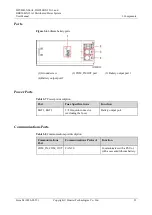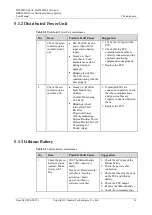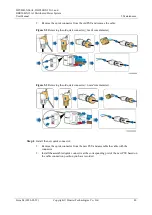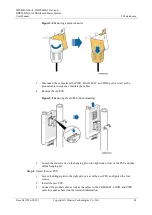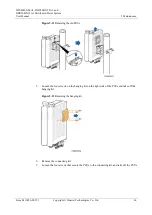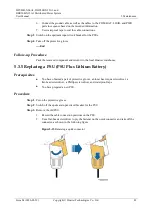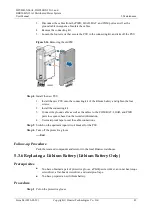
DPU40D-N06A3, DBU20B-N12A3, and
DBU50B-N12A1 Distributed Power System
User Manual
5 Maintenance
Issue 04 (2020-02-29)
Copyright © Huawei Technologies Co., Ltd.
34
2.
Check whether the AC overvoltage alarm threshold is correctly set. If not, adjust it based
on site requirements.
5.2.3 AC Undervoltage
Possible Causes
The grid power is unstable.
The AC undervoltage alarm threshold is incorrectly set.
Solution
1.
Measure the AC input voltage. If the voltage is abnormal, rectify the power grid fault.
2.
Check whether the AC undervoltage alarm threshold is correctly set. If not, adjust it
based on site requirements.
5.2.4 DC Overvoltage
Possible Causes
The rectifier is faulty.
The DC overvoltage alarm threshold is incorrectly set.
Solution
1.
Check whether the indicator on the rectifier is red. If so, replace the rectifier.
2.
Check whether the DC overvoltage alarm threshold is correctly set. If not, adjust it based
on site requirements.
5.2.5 DC Undervoltage
Possible Causes
The battery voltage is below the DC undervoltage alarm threshold.
The DC undervoltage alarm threshold is incorrectly set.
The DC output is short-circuited.
Solution
1.
Measure the AC input voltage. If the voltage is abnormal, rectify the power grid fault.
2.
Check whether the DC undervoltage alarm threshold is correctly set. If not, adjust it
based on site requirements.
3.
Remove the load and battery cables one by one and check whether the alarm is cleared.
If so, rectify the short circuit. If the battery fuse is blown or a cable is loosely connected,
check and rectify the fault.
5.2.6 Parallel Fail
Possible Causes
The parallel communications cable between rectifiers is loose.






